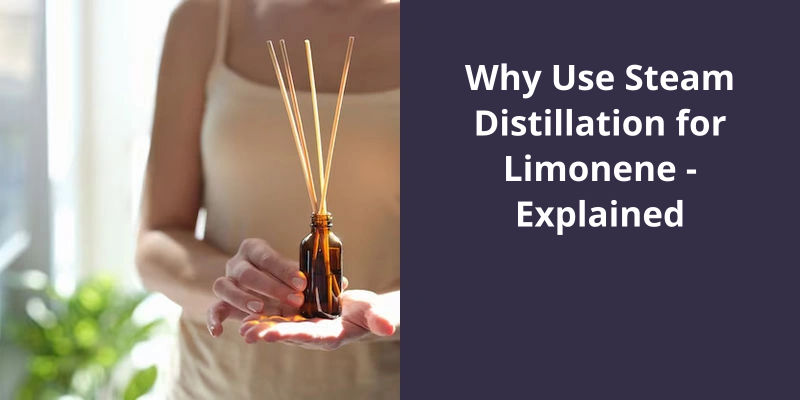Steam distillation is used for limonene because it effectively extracts this compound from citrus peels. The high temperature of steam helps to break down cell structures and liberates limonene contained within the oil-rich citrus peel, creating a mixture of steam and limonene vapor. As this mixture is cooled, limonene condenses back into a liquid, making it easier to separate it from the water. This method is efficient, yields high amounts of limonene, and maintains its purity because the heat of the steam does not destroy limonene as it evaporates under its own, much lower boiling point.

Why Is Limonene Isolated From Steam Distillation?
Limonene is a naturally occurring compound that’s commonly found in plants, especially citrus fruits. This compound is frequently used in a variety of industries, including the food, fragrance, and cleaning industries. It’s a refreshing and pleasant smell, which makes it an ideal ingredient for many products.
Steam distillation is an effective method for isolating limonene from plant materials. This process involves exposing the plant material to high temperatures and pressure, which causes the essential oils to evaporate. The vapor is then captured and condensed back into a liquid form, which is known as the distillate.
This means that it won’t dissolve in water and will instead separate as a distinct oily layer. By carefully removing this layer, the limonene can be collected and used in various applications.
The compound has a distinct citrus aroma and flavor, and is commonly used in beverages, baked goods, and other food products. It’s also used in perfumes, soaps, and other personal care products due to it’s pleasant scent.
It’s unique properties make it an important ingredient in a wide range of products, and it’s potential health benefits make it a valuable research area in the scientific community.
Now that we’ve an understanding of what steam distillation is and it’s primary usage, let’s explore some of the benefits that make it a preferred method of distillation for certain applications.
What Is Steam Distillation and When Is It a Preferred Method of Distillation?
The process involves heating water to produce steam which is then passed through the plant material in a distillation vessel. The steam and volatile components of the plant material rise and travel to the top of the vessel where they’re condensed back into a liquid form. The resulting mixture is then separated into two phases: an upper layer of essential oils and a lower layer of water.
One of the advantages of steam distillation is that it’s a gentle and environmentally friendly method of extraction. The process doesn’t involve the use of any harsh solvents or chemicals that can potentially harm the environment.
For example, it’s commonly used for the extraction of essential oils from plants, but it can also be used for the extraction of other compounds such as fatty acids, phenols and terpenoids. This versatility makes it a preferred method of distillation for many industries such as the food and beverage, fragrance and pharmaceutical industries.
For example, some compounds may be sensitive to heat or may be present in low concentrations, making them difficult to extract using traditional methods.
It’s important to weigh the pros and cons of different extraction methods before making a decision.
Conclusion
Compared to the traditional distillation method, steam distillation allows for a gentler approach that avoids the decomposition of limonene under high heat.





